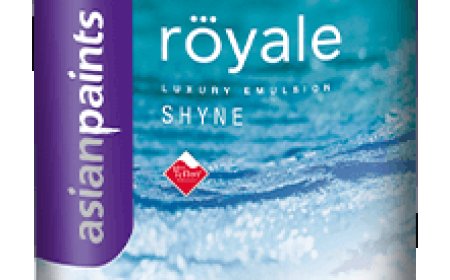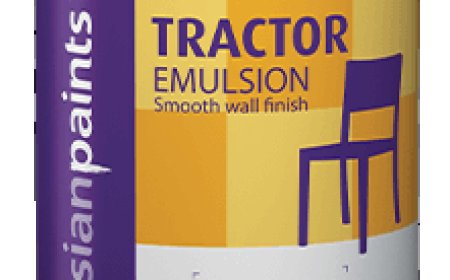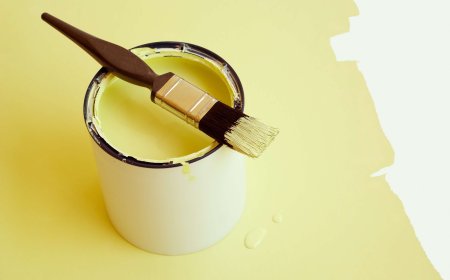Exterior House Painting Process | Step-by-Step Guide
With our complete guide to the Exterior House Painting Process, you can learn the critical steps for transforming the exterior of your home. Discover how to prepare, choose, and apply procedures that produce a beautiful finish. "Perfect for homeowners looking for a new look.

Exterior House Painting Process | Step-by-Step Guide
Introduction
Painting your home's exterior is essential to maintaining its honesty and attractiveness. Protecting your investment from environmental damage is more important than simply applying a new coat of paint. A well-painted exterior improves curb appeal, drawing in neighbors and possible purchasers to your house. Additionally, it acts as a protection against weather-related problems, avoid problems like mildew, mold, and decay. Painting your house on a regular basis also helps to keep its structural integrity intact by closing gaps and halting moisture entry. In the end, exterior house painting is more about safeguarding your property and making sure it lasts a long time than it is about beauty.
A step-by-step guide is incredibly helpful for beginners because it breaks down complex tasks into manageable, easy-to-follow steps. For someone new to exterior house painting, having a clear, structured process to follow can make all the difference. It eliminates confusion and uncertainty, allowing beginners to proceed with confidence. With a step-by-step guide, beginners can learn the basics of preparation, selecting the right materials, and applying paint correctly. It also helps them anticipate challenges and avoid common mistakes along the way. By following each step carefully, beginners can achieve professional-looking results while learning valuable skills that they can apply to future projects. In essence, a step-by-step guide provides the guidance and support that beginners need to tackle a new task successfully.
Preparation Phase
Assessing the Exterior
It is crucial to properly assess the state of the surfaces before beginning any outside house painting work. Check for deterioration by looking for things like wood rot, peeling paint, and cracks. In order to get a smooth and durable finish, these problems must be fixed prior to painting. In order to avoid pollutants such as mildew and dirt from affecting paint loyalty, carefully clean the surfaces. To guarantee ideal drying and curing, take into account the weather and select a suitable painting period. In order to achieve the greatest results, you should assess the outside surfaces' state beforehand in order to recognize any potential issues and take necessary steps to properly prepare them for painting.
One of the most important steps in getting ready for an outside house painting project is figuring out which areas require repair or extra attention. Keep an eye out for any areas that are breaking down or being damaged, such as holes, cracks, or paint that is coming off. To guarantee a smooth and even finish, these spots must be fixed before painting. Furthermore, be mindful of regions that could need extra attention, such high-traffic areas or surfaces that are exposed to moisture. You can guarantee that your paint job lasts longer and stop additional damage by taking care of these areas before painting. Before beginning the painting process, give your home's external surfaces a careful look and make any necessary repairs or preparations.
Gathering Supplies
The proper equipment and supplies must be on available in order to complete an exterior home painting job correctly. Paint brushes, rollers, extension poles, paint trays, and drop cloths to shield surfaces from spills and drips are a few necessities. A pressure washer or hose is also required for washing surfaces, and power sanders or sandpaper are needed for smoothing irregular spots. Always remember to keep painter's tape on hand for shielding trim and other areas you don't want painted. Select premium exterior paint that is appropriate for your environment and surface type, along with primers if necessary, when choosing your materials. Patching compound and plaster are also useful for restoring damaged areas and closing gaps and cracks.
Cleaning and Clearing
Cleaning the external surfaces is an important step before beginning a house painting process. First, use a pressure washer or a garden hose fitted with a nozzle attachment to remove any dirt, dust, or mildew development. Sections with significant deposits or stains require extra care. When dealing with tough stains, think about employing a scrub brush and a light detergent solution. Before beginning any repairs or painting, let the surfaces thoroughly dry after cleaning. Better loyalty and a smoother finish are guaranteed by doing this. In order to avoid causing harm when cleaning, pay extra attention to any nearby delicate surfaces or vegetation. These guidelines can help you achieve a more polished finish by making sure your external surfaces are clean and prepared for painting.
Surface Preparation
Repairing Damages
A smooth and long-lasting paint job requires the repair of holes, splits, and other problems on external surfaces. First, make sure all dirt and debris are gone by carefully cleaning the injured area. Then, fill up the holes and cracks with an appropriate filler material, like spackling compound, wood filler, or epoxy. Smooth and even with the surrounding surface, apply the filler with a putty knife. Before sanding the filler to a smooth finish, let it dry completely in accordance with the manufacturer's instructions. You can start priming and painting as soon as the repaired areas are smooth and dry. Your external paint work will last longer if these defects are patched, ensuring a smooth and polished finish.
Power Washing
An important step in getting your home's external surfaces ready for painting is power washing. The surface is left clean and smooth after using high-pressure water to remove filth, particles, and old paint. Power washing removes these particles, which improves the fresh paint's dedication and produces a longer-lasting surface. Before painting, you can take care of any hidden damage or spots that require repair because it helps disclose them. A fast and effective method of renewing the outside of your house and improve its overall appeal is power washing.
In order to avoid mishaps or injuries, safety should always come first when using a power washer. Begin by putting on suitable protection gear, such as safety goggles to screen your eyes from dust and strong, non-slip shoes to prevent falls. Make sure you are comfortable with the controls of the power washer by carefully reading the manufacturer's instructions before using it. Keep a safe distance from windows, electrical outlets, and other delicate locations when using the power washer to avoid any damage. Be aware of your surroundings. Remember to never aim the spray nozzle directly at people or yourself, and stay away from sprinkling plants or delicate objects. To be sure it's perfect for the surface you're cleaning, always test the pressure and spray pattern on a tiny, clear area before beginning.
Priming
Primer is essential for painting external walls of houses since it gets surfaces ready for paint application. It improves the stability and longevity of the paint work by acting as a bonding agent between the paint and the surface. Additionally, primer aids in sealing surfaces with holes, limiting the chance of problems like peeling and cracking by stopping moisture entry. It also improves the final paint coat's color and quality, smoothing out any uneven surface texture. Applying primer before to painting the external surfaces of your house helps shield your investment from wear and weather damage and guarantees a smoother, longer-lasting finish.
A successful exterior painting project depends on selecting the appropriate primer, since different materials require different kinds of primer to achieve the best results. Choose a premium wood primer, for example, to seal the surface and stop tannin bleed-through when painting wood siding. Select a primer that stops rust on metal surfaces to stop rust and guarantee paint loyalty. A bonding primer works great for improving dedication and avoiding peeling or flaking when painting over previously painted surfaces. Choose a primer that is made to survive harsh weather conditions by taking into account other factors like high humidity and low temperatures. A successful and long-lasting paint application on your surface can be ensured by selecting the appropriate primer for the particular material and conditions.
Painting Phase
If you want your exterior painting project to seem neat and professional, you must learn how to cut in around windows, doors, and other edges. A good angled brush is a good place to start because it offers more control and accuracy. Tapping off extra paint carefully avoids leaks. Put the brush into the paint. Starting with small bits at a time, start cutting in along the edges. To guarantee even covering, use steady, fluid strokes and try to gently overlap onto the surrounding area. Take your time and use a steady hand to cut exactly where windows and doors are located so that the lines and corners are clean. To produce even cleaner lines, mask off sections using painter's tape if needed.
Rolling or Spraying
When applying paint with a roller or sprayer, it's important to follow a few key instructions for best results. Firstly, ensure that your surface is clean, dry, and properly prepared before painting. Then, if using a roller, pour your paint into a paint tray and load the roller evenly. Start by painting in a "W" or "M" pattern to evenly distribute the paint, then roll vertically in long strokes to cover the entire surface. For a sprayer, adjust the nozzle to achieve the desired spray pattern and pressure. Hold the sprayer about 12-18 inches away from the surface and apply the paint in smooth, overlapping strokes. Be sure to maintain a consistent distance and speed for uniform coverage. Whichever method you choose, work in small sections at a time and allow the paint to dry completely between coats. By following these instructions, you can achieve a smooth and professional-looking finish on your exterior surfaces.
To achieve even coverage and avoid drips when painting, there are several helpful tips to keep in mind. Firstly, use the right amount of paint on your roller or brush—avoid overloading, as excess paint can lead to drips and uneven application. Start with a small amount and gradually add more as needed. Additionally, maintain a consistent pressure and speed when applying the paint, whether using a roller or brush. Avoid pressing too hard, as this can cause drips, and work in small sections to ensure thorough coverage without rushing. If you notice any drips forming, quickly smooth them out with your brush or roller before they dry. Finally, always follow the manufacturer's recommended drying times between coats to prevent drips and achieve a smooth finish. By following these tips, you can achieve even coverage and professional-looking results on your exterior painting project.
Layering
Applying multiple coats of paint is essential for ensuring durability and longevity in your exterior painting project. Each coat adds an extra layer of protection against the elements, helping to shield your home from moisture, UV rays, and other environmental factors. Additionally, multiple coats help to achieve a more even and consistent finish, covering any imperfections or inconsistencies in the surface. By layering the paint, you create a stronger barrier that resists chipping, peeling, and fading over time. While it may require a bit more time and effort upfront, investing in multiple coats of paint pays off in the long run by extending the life of your paint job and keeping your home looking fresh and vibrant for years to come.
Allowing sufficient drying time between coats is crucial for achieving a successful exterior painting project. Typically, you should wait for the first coat to dry completely before applying the second coat. The exact drying time can vary depending on factors such as temperature, humidity, and the type of paint used. As a general guideline, it's advisable to wait at least 4-6 hours between coats. However, in cooler or more humid conditions, you may need to wait longer. Always refer to the manufacturer's instructions on the paint can for specific drying times. Rushing the drying process can lead to poor adhesion, streaks, or even paint lifting off, so it's essential to be patient and allow each coat to dry thoroughly before proceeding with the next one.
What's Your Reaction?


























